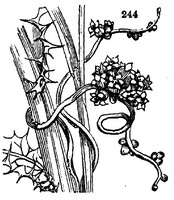1105. Plants strictly parasitical may be placed in the second subdivision. By these are meant all such as do actually abstract from the juices of the plant to which they cling, the nourishment necessary to the developement of their parts ; and of which the most common, at least as being indigenous to Britain, are the mistletoe, dodder, broom-rape, and a sort of tuber that grows on the root of saffron, and destroys it if allowed to spread. The Mistletoe (Viscum album) is found for the most part on the apple-tree, the lime, the hawthorn, the poplar, and some other trees. If its berry is made to adhere to the trunk or branch of either of the foregoing trees, which from its glutinous nature it may readily be made to do, it germinates by sending out a small globular body attached to a pedicle, which after it acquires a certain length bends towards the bark, into which it insinuates itself by means of a number of small fibres which it now protrudes, and by which it abstracts from the plant the nourishment necessary to its future developement. When the root has thus fixed itself in the bark of the supporting tree, the stem of the parasite begins to ascend, at first smooth and tapering, and of a pale green colour, but finally protruding a multiplicity of branches and leaves. It seems to have been thought by some botanists that the roots of the mistletoe penetrate even into the wood, as well as through the bark. But the observations of Du Hamel show that this opinion is not well founded. The roots are indeed often found within the wood, which they thus seem to have penetrated by their own vegetating power. But the fact is, that they are merely covered by the additional layers of wood that have been formed since the fibres first insinuated themselves into the bark. The Cuscuta europï¾µ'a, or Dodder (fig. 244.), though it is to be accounted a truly parasitical plant in the issue, if yet not originally so. For the seed of this plant when it has fallen to the ground takes root originally by sending down its radicle into the soil and elevating its stem into the air. It is not yet, therefore, a parasitical plant. But the stem which is now elevated above the surface lays hold of the first plant it meets with, though it is particularly partial to hops and nettles, and twines itself around it, attaching itself by means of little parasitical roots at the points of contact, and finally detaching itself from the soil altogether by the decay of the original root, and becoming a truly parasitical plant. Withering describes the plant in his arrangement as being originally parasitical; but this is certainly not the fact. The Orobanche, or Broom-rape, which attaches itself by the root to the roots of other plants, it also to be regarded as being truly parasitical, though it sometimes sends out fibres which seem to draw nourishment from the earth. It is found most frequently on the roots of the common broom.

